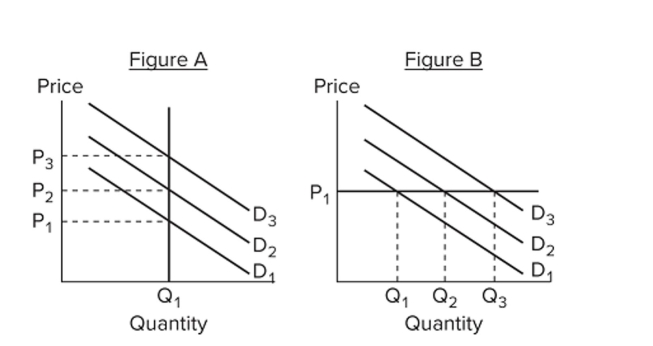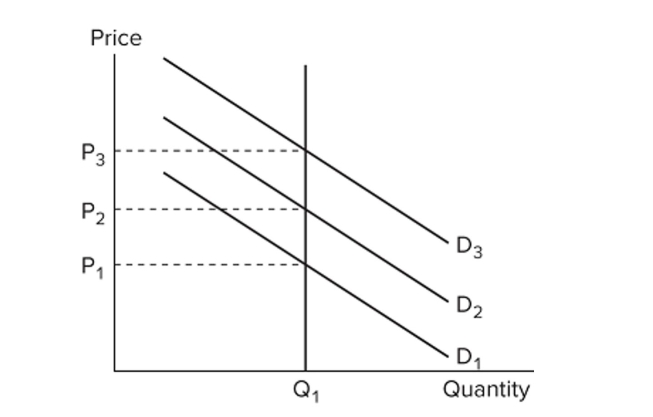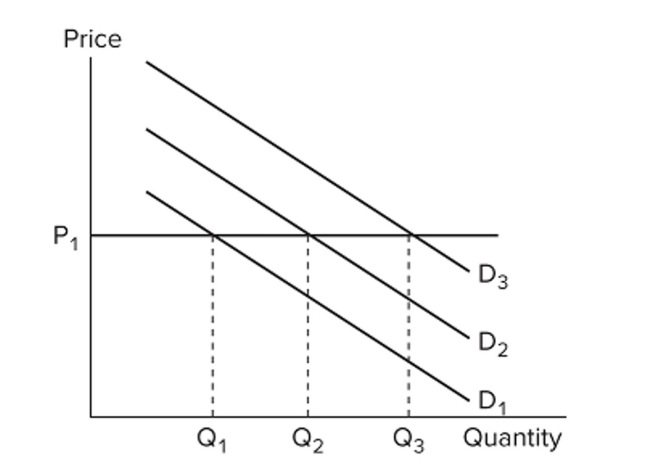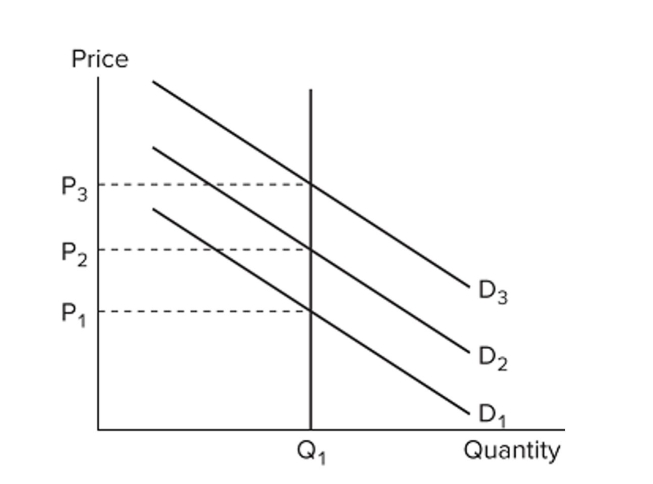A) the shift from D2 to D3 in graph B
B) the shift from D2 to D3 in graph A
C) the shift from D2 to D1 in graph B
D) the shift from D2 to D1 in graph A
F) A) and B)
Correct Answer

verified
Correct Answer
verified
Multiple Choice
When economists refer to "investment," they are describing a situation where
A) people are buying shares of corporate stock.
B) resources are devoted to increasing future output.
C) money is saved in a bank account.
D) financial assets are purchased in the hope of a monetary gain.
F) None of the above
Correct Answer

verified
Correct Answer
verified
Multiple Choice
The Great Recession illustrated the situation where a negative demand shock occurred and
A) prices adjusted but the output level was inflexible.
B) the economy's overall price level was very flexible.
C) the economy's overall price level was "sticky."
D) prices and production were both "sticky," or inflexible.
F) B) and C)
Correct Answer

verified
Correct Answer
verified
Multiple Choice
If consumers become pessimistic, the economy is likely to experience a
A) negative demand shock.
B) positive demand shock.
C) negative supply shock.
D) positive supply shock.
F) None of the above
Correct Answer

verified
Correct Answer
verified
True/False
Economists believe that expectations have little impact on macroeconomic outcomes.
B) False
Correct Answer

verified
Correct Answer
verified
True/False
In 2008-2009, the U.S. economy lost 8 million jobs and saw the economic growth rate fall to negative 2.4 percent.
B) False
Correct Answer

verified
Correct Answer
verified
Multiple Choice
For which of the following goods are services prices least sticky?
A) newspapers
B) haircuts
C) microwave ovens
D) airline tickets
F) C) and D)
Correct Answer

verified
Correct Answer
verified
Multiple Choice
 Refer to the figures. Which figure(s) represent(s) a situation where firms are likely to hold inventories to accommodate unexpected changes in demand?
Refer to the figures. Which figure(s) represent(s) a situation where firms are likely to hold inventories to accommodate unexpected changes in demand?
A) A only
B) B only
C) both A and B
D) neither A nor B
F) B) and C)
Correct Answer

verified
Correct Answer
verified
Multiple Choice
Nominal gross domestic product
A) is not affected by the level of inflation.
B) changes only when there is a change in output.
C) changes only when there is a change in the price level.
D) can change when there is a change in either output or the price level.
F) B) and C)
Correct Answer

verified
Correct Answer
verified
True/False
Businesses are the main economic investors, while households are the main savers.
B) False
Correct Answer

verified
Correct Answer
verified
Multiple Choice
Nominal gross domestic product
A) is a measure of the overall level of prices.
B) measures the value of final output produced within a nation in one year, using current prices.
C) measures the value of final output produced within a nation in one year, adjusted for changing prices.
D) only changes when the level of output changes.
F) All of the above
Correct Answer

verified
Correct Answer
verified
Multiple Choice
In situations of sticky prices and negative demand shocks, we would expect firms to
A) deplete inventories before increasing production.
B) reduce production before building up inventories.
C) build up inventories before reducing production.
D) lower prices before reducing production or building up inventories.
F) A) and D)
Correct Answer

verified
Correct Answer
verified
True/False
Banks and other financial institutions provide the link between savers and economic investors in the macroeconomy.
B) False
Correct Answer

verified
Correct Answer
verified
Multiple Choice
 Refer to the figure. Assuming this market is representative of the economy as a whole, a positive demand shock will
Refer to the figure. Assuming this market is representative of the economy as a whole, a positive demand shock will
A) increase both the price level and the quantity of output produced.
B) increase output but leave prices unchanged.
C) lower the price level but leave output unchanged.
D) raise the price level but leave output unchanged.
F) All of the above
Correct Answer

verified
Correct Answer
verified
Multiple Choice
(Last Word) Studies in behavioral economics show that when firms cut worker's pay in order to reduce costs during recessions, the workers
A) feel like they are being taken advantage of.
B) may begin organizing unions.
C) retaliate by stealing supplies and vandalizing equipment.
D) call in sick and show up late more often.
E) All of these choices are correct.
G) A) and B)
Correct Answer

verified
Correct Answer
verified
True/False
A period of declining output and living standards is referred to as a recession.
B) False
Correct Answer

verified
Correct Answer
verified
Multiple Choice
 The figure depicts a situation where
The figure depicts a situation where
A) prices are sticky, but output is flexible.
B) prices are flexible, but output is constant.
C) prices and output are both flexible.
D) prices are sticky and output is constant.
F) A) and C)
Correct Answer

verified
Correct Answer
verified
Multiple Choice
Inventories held by firms
A) tend to increase the severity of short-run fluctuations.
B) tend to reduce the severity of short-run fluctuations.
C) are held by businesses because they are a costless way of responding to demand shocks.
D) are the result of positive demand shocks.
F) None of the above
Correct Answer

verified
Correct Answer
verified
Multiple Choice
Unemployment describes the condition where
A) equipment and machinery are going unused.
B) a person cannot get a job but is willing to work and is actively seeking work.
C) a person does not have a job, regardless of whether or not he or she wants one.
D) any resource sits idle.
F) A) and C)
Correct Answer

verified
Correct Answer
verified
Multiple Choice
 Refer to the figure. Assuming this market is representative of the economy as a whole, a negative demand shock will
Refer to the figure. Assuming this market is representative of the economy as a whole, a negative demand shock will
A) cause inflation.
B) increase unemployment.
C) lower prices but leave output unaffected.
D) reduce both prices and output.
F) B) and D)
Correct Answer

verified
Correct Answer
verified
Showing 161 - 180 of 243
Related Exams